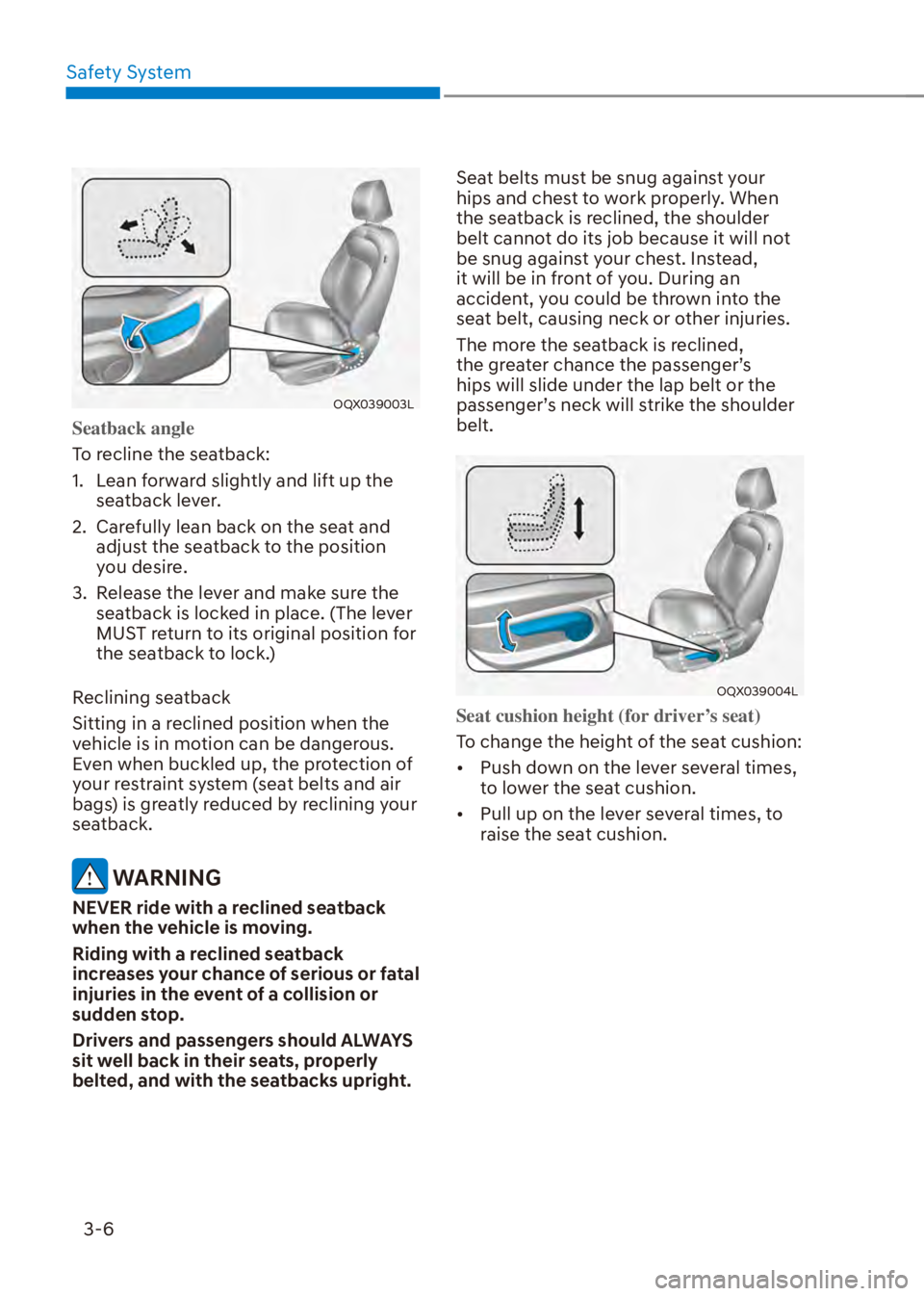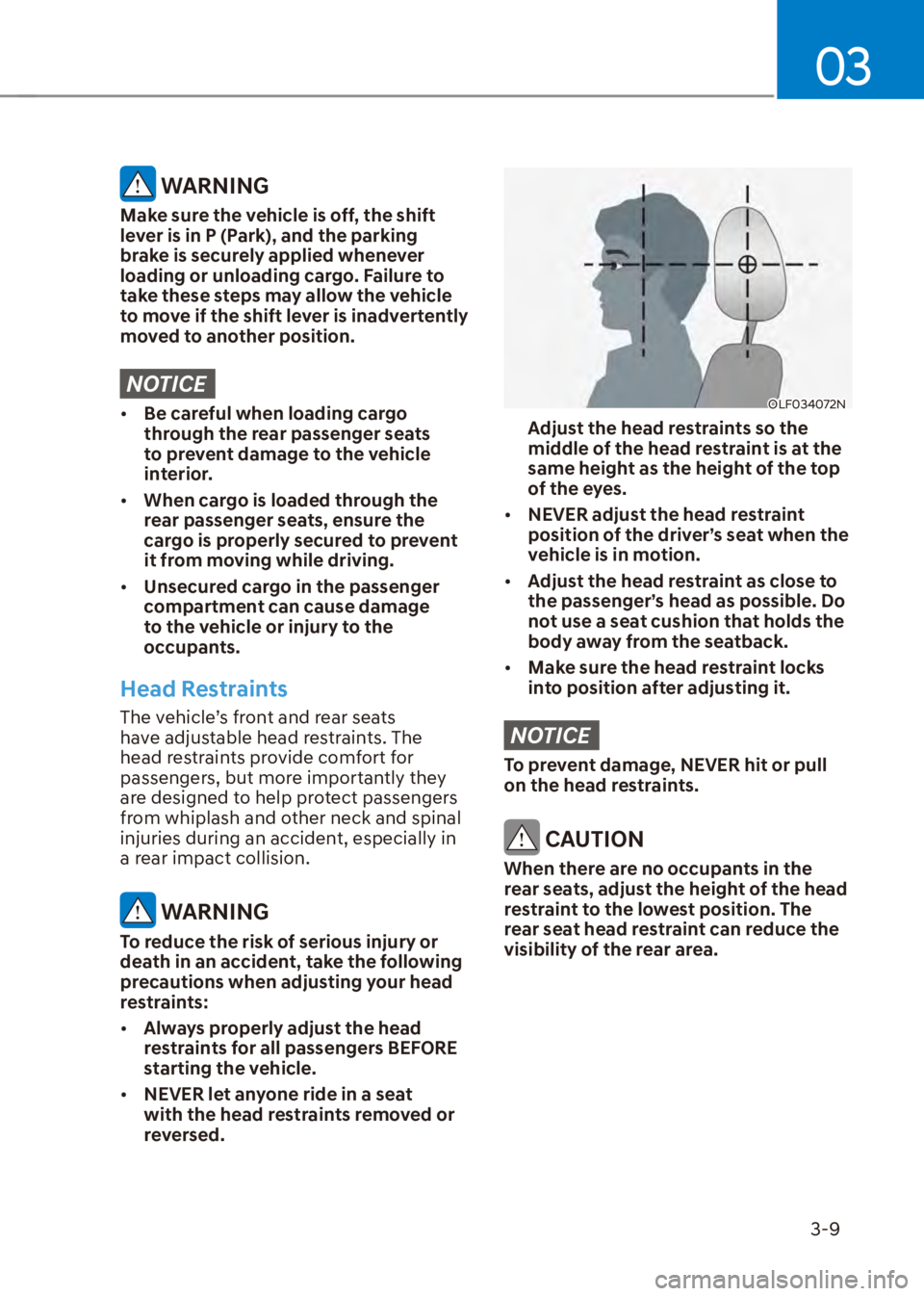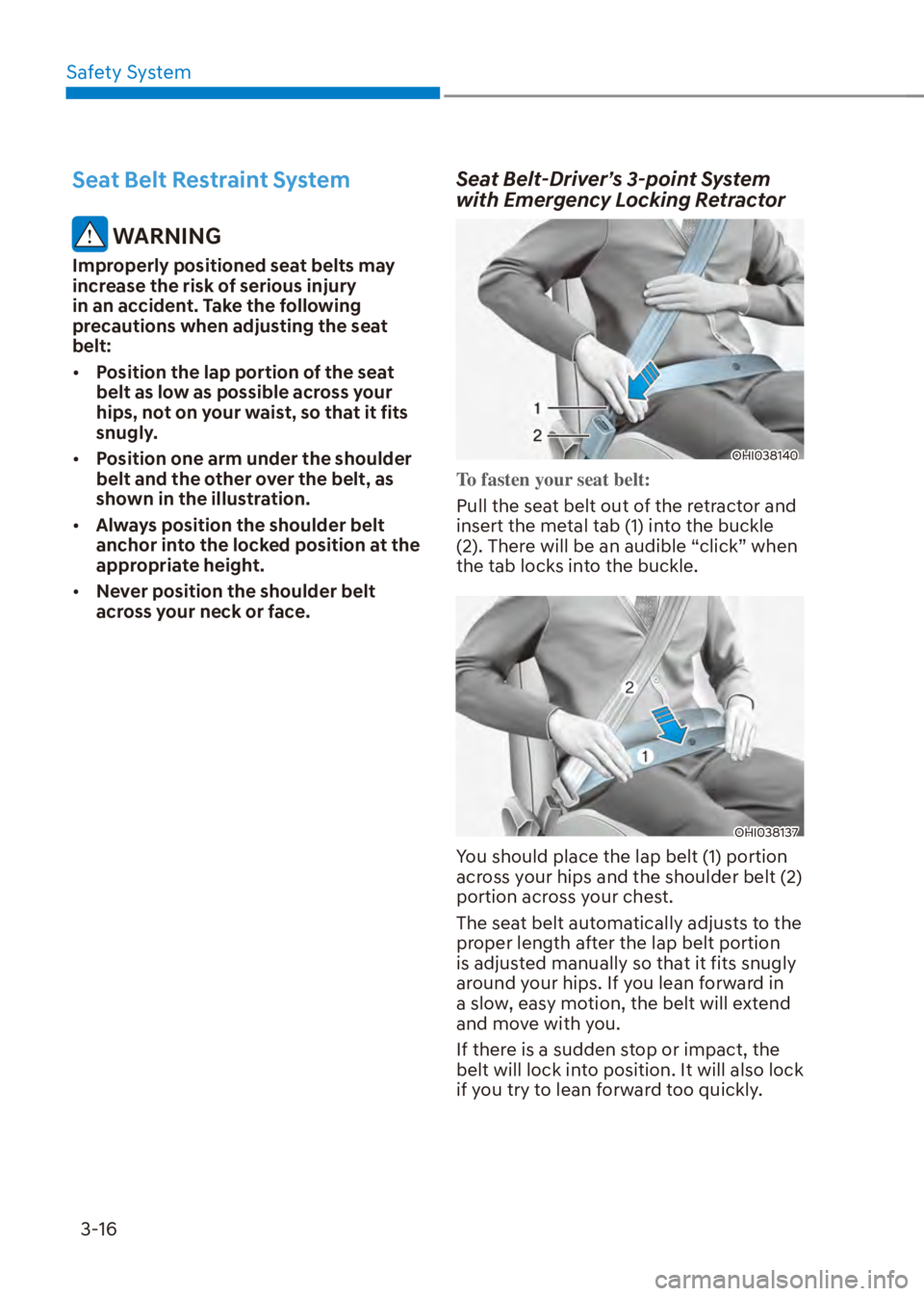Page 20 of 390
02
2-7
DIMENSIONS
Itemin (mm)
Overall length 159.0 (4,040)
O
verall width 69.7 (1,770)
Overall height With roof rack
62.7 (1,592)
Without roof rack 61.6 (1,565)
Front tread 185/65R15 (6.0J)
61.2 (1,555)
205/55R17 (6.5J) 60.4 (1,535)
Rear tread 185/65R15 (6.0J)
61.6 (1,565)
205/55R17 (6.5J) 60.9 (1,546)
Wheelbase 99.2 (2,520)
ENGINE
ItemSmartstream G1.6
Displacement cu.in (
cc)97.5 (1,598)
Bore x Stroke in (mm)2.98 x 3.5 (75.6 x 89.0)
Firing order 1-3-4-2
No. of cylinders 4, in-line
Page 30 of 390
3-3
03
Front seats
(1) Forward and backward
(2) Seatback angle
(3) Seat cushion height
(4) Head restraint
(5) Seat warmerRear seats
(6) Head restraint
(7) Seatback folding
SEATS
OQX039001N
Page 33 of 390

Safety System3-6
OQX039003L
Seatback angle
To recline the seatback:
1.
Lean forward slightly and lift up the
seatback lever.
2. Carefully lean back on the seat and adjust the seatback to the position
you desire.
3. Release the lever and make sure the seatback is locked in place. (The lever
MUST return to its original position for
the seatback to lock.)
Reclining seatback
Sitting in a reclined position when the
vehicle is in motion can be dangerous.
Even when buckled up, the protection of
your restraint system (seat belts and air
bags) is greatly reduced by reclining your
seatback.
WARNING
NEVER ride with a reclined seatback
when the vehicle is moving.
Riding with a reclined seatback
increases your chance of serious or fatal
injuries in the event of a collision or
sudden stop.
Drivers and passengers should ALWAYS
sit well back in their seats, properly
belted, and with the seatbacks upright. Seat belts must be snug against your
hips and chest to work properly. When
the seatback is reclined, the shoulder
belt cannot do its job because it will not
be snug against your chest. Instead,
it will be in front of you. During an
accident, you could be thrown into the
seat belt, causing neck or other injuries.
The more the seatback is reclined,
the greater chance the passenger’s
hips will slide under the lap belt or the
passenger’s neck will strike the shoulder
belt.
OQX039004L
Seat cushion height (for driver’s seat)
To change the height of the seat cushion:
�[��
Push do
wn on the lever several times,
to lower the seat cushion.
�[�� Pull up on the lever several times, to
raise the seat cushion.
Page 36 of 390

03
3-9
WARNING
Make sure the vehicle is off, the shift
lever is in P (Park), and the parking
brake is securely applied whenever
loading or unloading cargo. Failure to
take these steps may allow the vehicle
to move if the shift lever is inadvertently
moved to another position.
NOTICE
�[��Be careful when loading cargo
through the rear passenger seats
to prevent damage to the vehicle
interior.
�[�� When cargo is loaded through the
rear passenger seats, ensure the
cargo is properly secured to prevent
it from moving while driving.
�[�� Unsecured cargo in the passenger
compartment can cause damage
to the vehicle or injury to the
occupants.
Head Restraints
The vehicle’s front and rear seats
have adjustable head restraints. The
head restraints provide comfort for
passengers, but more importantly they
are designed to help protect passengers
from whiplash and other neck and spinal
injuries during an accident, especially in
a rear impact collision.
WARNING
To reduce the risk of serious injury or
death in an accident, take the following
precautions when adjusting your head
restraints:
�[��Always properly adjust the head
restraints for all passengers BEFORE
starting the vehicle.
�[�� NEVER let anyone ride in a seat
with the head restraints removed or
reversed.
OLF034072N
Adjust the head restraints so the
middle of the head restraint is at the
same height as the height of the top
of the eyes.
�[�� NEVER adjust the head restraint
position of the driver’s seat when the
vehicle is in motion.
�[�� Adjust the head restraint as close to
the passenger’s head as possible. Do
not use a seat cushion that holds the
body away from the seatback.
�[�� Make sure the head restraint locks
into position after adjusting it.
NOTICE
To prevent damage, NEVER hit or pull
on the head restraints.
CAUTION
When there are no occupants in the
rear seats, adjust the height of the head
restraint to the lowest position. The
rear seat head restraint can reduce the
visibility of the rear area.
Page 37 of 390
Safety System3-10
Front Seat head Restraints
OQX039008L
Both the driver’s and passenger’s front
seat are equipped with adjustable head
restraints for the safety and comfort.
OQX039009L
Adjusting the height up and down
To raise the head restraint:
1.
Pull it up to the desired position (1).
To lower the head restraint:
1. Push and hold the release button (2) on the head restraint support.
2. Lower the head restraint to the desired position (3).
OLF034015
NOTICE
If you recline the seatback towards the
front with the head restraint and seat
cushion raised, the head restraint may
come in contact with the sunvisor or
other parts of the vehicle.
OQX039010L
Removal/Reinstallation
To remove the head restraint:
1.
Recline the seatback (2) rearward
using the seatback angle lever (1).
2. Raise the head restraint as far as it can go.
3. Press the head restraint release button (3) while pulling the head restraint up
(4).
Page 38 of 390
03
3-11
OQX039011L
To reinstall the head restraint:
1. Put the head restraint poles (2) into the holes while pressing the release
button (1).
2. Adjust the head restraint to the appropriate height.
3. Adjust the seatback (4) forward using the seatback angle lever (3).
Rear Seat head Restraints
OQX039032L
The rear seats are equipped with head
restraints in all the seating positions for
the passenger’s safety and comfort.
CAUTION
�[��For each rear passenger, adjust the
head restraint so that the middle
of the head restraint is at the same
height as the height of the top of the
eyes.
�[��When seating on the rear seat, do
not adjust the height of the head
restraints to the lowest position.
OQX039015N
Adjusting the height up and down
To raise the head restraint:
1.
Pull it up to the desired position (1).
To lower the head restraint:
1. Push and hold the release button (2) on the head restraint support.
2. Lower the head restraint to the desired position (3).
Page 39 of 390

Safety System3-12
OQX039015N
Removal/Reinstallation
To remove the head restraint:
1.
Raise the head restraint as far as it can
go.
2. Press the head restraint release button (2) while pulling the head restraint up
(1).
To reinstall the head restraint:
1. Put the head restraint poles into the holes (3) while pressing the release
button (2).
2. Adjust the head restraint to the appropriate height.
Seat Warmers (if equipped)
Seat warmers are provided to warm the
seats during cold weather.
WARNING
The seat warmers can cause a SERIOUS
BURN, even at low temperatures and
especially if used for long periods of
time.
Passengers must be able to feel if the
seat is becoming too warm so they can
turn it off, if needed.
People who cannot detect temperature
change or pain to the skin should
use extreme caution, especially the
following types of passengers:
�[��Infants, children, elderly or disabled
persons, or hospital outpatients.
�[�� People with sensitive skin or who
burn easily.
�[�� Fatigued individuals.
�[�� Intoxicated individuals.
�[�� People taking medication that can
cause drowsiness or sleepiness.
WARNING
NEVER place anything on the seat
that insulates against heat when the
seat warmer is in operation, such as a
blanket or seat cushion. This may cause
the seat warmer to overheat, causing a
burn or damage to the seat.
Page 43 of 390

Safety System3-16
Seat Belt Restraint System
WARNING
Improperly positioned seat belts may
increase the risk of serious injury
in an accident. Take the following
precautions when adjusting the seat
belt:
�[�� Position the lap portion of the seat
belt as low as possible across your
hips, not on your waist, so that it fits
snugly.
�[�� Position one arm under the shoulder
belt and the other over the belt, as
shown in the illustration.
�[�� Always position the shoulder belt
anchor into the locked position at the
appropriate height.
�[�� Never position the shoulder belt
across your neck or face.
Seat Belt-Driver’s 3-point System
with Emergency Locking Retractor
OHI038140
To fasten your seat belt:
Pull the seat belt out of the retractor and
insert the me
tal tab (1) into the buckle
(2). There will be an audible “click” when
the tab locks into the buckle.
OHI038137
You should place the lap belt (1) portion
across your hips and the shoulder belt (2)
portion across your chest.
The seat belt automatically adjusts to the
proper length after the lap belt portion
is adjusted manually so that it fits snugly
around your hips. If you lean forward in
a slow, easy motion, the belt will extend
and move with you.
If there is a sudden stop or impact, the
belt will lock into position. It will also lock
if you try to lean forward too quickly.